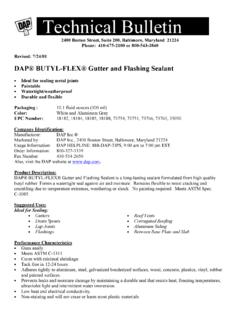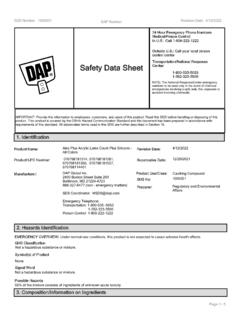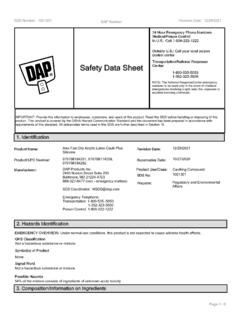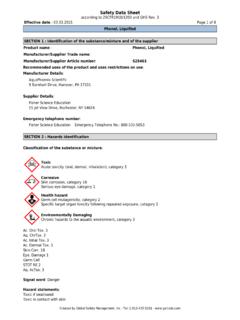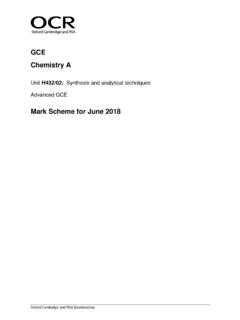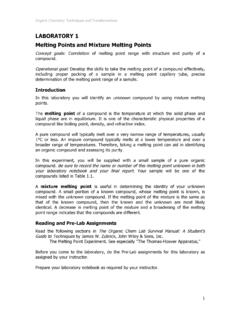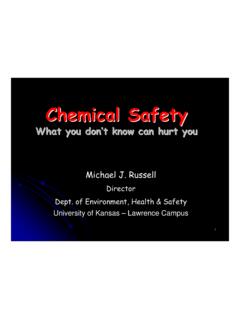Transcription of Safety Data Sheet - DAP Products
1 SDS Number: 1021104 Revision Date: 4/12/2022 SAP Number: Safety Data Sheet24 Hour Emergency Phone NumbersMedical/Poison Control:In : Call 1-800-222-1222 Outside : Call your local poisoncontrol centerTransportation/National ResponseCenter:1-800-535-50531-352-323-3 500 NOTE: The National ResponseCenter emergencynumbers to be used only in the event of chemicalemergencies involving a spill, leak, fire, exposure oraccident involving : Provide this information to employees, customers, and users of this product . Read this SDS before handling or disposing of thisproduct. This product is covered by the OSHA Hazard Communication Standard and this document has been prepared in accordance withrequirements of this standard. All abbreviated terms used in this SDS are further described in Section IdentificationProduct Name:Weldwood Original Contact Cement VialRevision Date:4/12/202212/29/2021 product UPC Number:070798001299 Supercedes Date: product Use/Class:AdhesiveManufactured ForDAP Global Boston Street Suite 200 Baltimore, MD 21224-4723888-327-8477 (non - emergency matters)SDS Coordinator: Telephone: 1-800-535-5053,1-352-323-3500, 1-800-222-1222 SDS No:1021104 Preparer:Regulatory and EnvironmentalAffairs2.
2 Hazards IdentificationEMERGENCY OVERVIEW: DANGER!Extremely flammable liquid and vapor. Vapors may cause flash fire or explosion. Vapors can form an ignitable mixture with air. Vapors can flow along surfaces to a distant ignition source and flash back. Flammable liquid and vapor. Vapors can form an ignitable mixture with air. Vapors can flow along surfaces to a distant ignition source and flash back. Do not smoke. Extinguish all flames and pilot lights, and turn off stoves, heaters, electric motors and other sources of ignition during use and until all vapors are gone. Keep container closed and away from heat, sparks, and open flame. Store away from caustics and oxidizers. Avoid breathing vapor. Avoid skin and eye contact. Use only with adequate ventilation. Prevent build-up of vapors by opening all windows and doors to achieve cross-ventilation. Irritating to eyes, respiratory system and skin. Harmful or fatal if swallowed. Aspiration hazard if swallowed - can enter lungs and cause damage.
3 May affect the brain or nervous system causing dizziness, headache or 1 / 7 SDS Number: 1021104 Revision Date: 4/12/2022 SAP Number:GHS ClassificationAcute Tox. 4 Inhalation, Eye Irrit. 2, Flam. Liq. 2, Muta. 1B, Skin Irrit. 2, Skin Sens. 1, STOT SE 3 NESymbol(s) of ProductSignal WordDangerPossible Hazards10% of the mixture consists of ingredients of unknown acute toxicityGHS HAZARD STATEMENTSF lammable Liquid, category 2H225 Highly flammable liquid and Irritation, category 2H315 Causes skin Sensitizer, category 1H317 May cause an allergic skin Irritation, category 2H319 Causes serious eye Toxicity, Inhalation, category 4H332 Harmful if , single exposure, category 3, NEH336 May cause drowsiness or Cell Mutagenicity, category 1BH340 May cause genetic defects .GHS LABEL PRECAUTIONARY STATEMENTSP201 Obtain special instructions before away from heat, hot surfaces, sparks, open flames and other ignition sources. breathing dust/fume/gas/mist/ thoroughly after only outdoors or in a well-ventilated work clothing should not be allowed out of the protective gloves/protective clothing/eye protection/face +P352IF ON SKIN: Wash with plenty of soap and +P361+P353IF ON SKIN (or hair): Take off immediately all contaminated clothing.
4 Rinse skin +P340IF INHALED: Remove person to fresh air and keep comfortable for +P351+P338IF IN EYES: Rinse cautiously with water for several minutes. Remove contact lenses, ifpresent and easy to do. Continue +P313IF exposed or concerned: Get medical a POISON CENTER or doctor/physician if you feel treatment (see .. on this label).P332+P313If skin irritation occurs: Get medical +P313If skin irritation or rash occurs: Get medical +P313If eye irritation persists: Get medical off contaminated +P378In case of fire: to +P233 Store in a well-ventilated place. Keep container tightly +P235 Store in a well-ventilated place. Keep locked of SDS PRECAUTIONARY STATEMENTSP240 Ground/bond container and receiving explosion-proof electrical/ventilating/lighting/../ only non-sparking precautionary measures against static contaminated clothing before Composition/Information on IngredientsChemical %GHS SymbolsGHS StatementsEthyl acetate141-78-610-30 GHS02-GHS07H225-319-332-336 Page 2 / 7 SDS Number: 1021104 Revision Date: 4/12/2022 SAP Number:Methyl ethyl ketone (MEK)78-93-310-30 GHS02-GHS07H225-319-332-336VM & P Naphtha8032-32-410-30 GHS06-GHS08H304-331-340 Acetone67-64-110-30 GHS02-GHS07H225-319-336 phenol -formaldehyde Resin, Novolac9003-35-47-13 GHS07H315-317-319 The text for GHS Hazard Statements shown above (if any) is given in the "Other information" first -aid MeasuresFIRST AID - INHALATION: If inhaled, remove to fresh air.
5 If not breathing, give artificial respiration. If breathing is difficult, give oxygen. Get medical attention immediately. NOTE: Only trained personnel should administer artificial respiration or give AID - SKIN CONTACT: Wash skin with soap and water for 15 minutes. Get medical aid if symptoms persist. Remove and wash contaminated clothing. DO NOT try to peel the solidified material from the skin or use solvents or thinners to dissolve it. The use of vegetable oil or mineral oil is recommended for removal of this material from the skin. Flush exposed area with water while removing contaminated clothing. Get medical attention if irritation persists. To remove from skin, remove completely with a dry cloth or paper towel, before washing with detergent and AID - EYE CONTACT: If material gets into eyes, flush with water immediately for 15 minutes. Consult a AID - INGESTION: If swallowed, DO NOT INDUCE VOMITING. Get medical attention Fire-fighting MeasuresUNUSUAL FIRE AND EXPLOSION HAZARDS: Eliminate sources of ignition: heat, electrical equipment, sparks and flames.
6 Vapors can form an ignitable mixture with air. Vapors can flow along surfaces to a distant ignition source and flash back. Vapors may form explosive mixtures with air. Containers may explode if exposed to extreme heat. Empty containers retain product residue (liquid and/or vapor). Vapor can ignite potentially causing an FIREFIGHTING PROCEDURES: Wear self-contained breathing apparatus pressure-demand (NIOSH approved or equivalent) and full protective gear. Use water spray to cool exposed surfaces. Cool fire-exposed containers using water MEDIA: Alcohol Foam, Carbon Dioxide, Dry Chemical, Foam, Water Spray or Fog, Water6. Accidental Release MeasuresENVIRONMENTAL MEASURES: No InformationSTEPS TO BE TAKEN IF MATERIAL IS RELEASED OR SPILLED: NOTE: Review fire hazards before proceeding with clean up. Immediately eliminate sources of ignition. Keep people away from and upwind of spill/leak. Contain spilled material and remove with inert absorbent.
7 Dispose of contaminated absorbent, container and unused contents in accordance with local, state and federal regulations. Prevent product from entering drains. Soak up with inert absorbent material and dispose of as hazardous waste. Read all product instructions before using. Personal protective equipment should include impervious gloves, protective eye wear, and suitable work clothes. Scrape up dried material and place into Handling and StorageHANDLING: KEEP OUT OF REACH OF CHILDREN!DO NOT TAKE INTERNALLY. Remove all sources of ignition. Keep away from open flames, hot surfaces and sources of ignition. Provide adequate ventilation. Avoid heat, sparks and open flames. Wear appropriate personal protection. Avoid breathing vapor and contact with eyes, skin and clothing. Use in well ventilated area. Open all windows and doors or use other means to ensure cross-ventilation and fresh air entry during application and drying. Odor is not an adequate warning for hazardous conditions.
8 Empty containers retain product residue (liquid and/or vapor). Vapor can ignite potentially causing an explosion. Wash thoroughly after handling. Do not use in areas where static sparks may be generated. Intentional misuse by deliberately concentrating and inhaling vapors may be harmful or fatal. Construction and repair activities can adversely affect indoor air quality. Consult with occupants or a representative ( maintenance, building manager, industrial hygienist, or Safety officer) to determine ways to minimize : Store away from sources of ignition and heat. Do not store at temperatures above 120 F (49 C). Store containers away from excessive heat and freezing. Store away from caustics and oxidizers. Keep containers tightly Exposure Controls/Personal ProtectionIngredients with Occupational Exposure LimitsChemical NameACGIH TLV-TWAACGIH-TLV STELOSHA PEL-TWAOSHA PEL-CEILINGE thyl acetate400 ppm ppm TWA,1400 mg/m3 ethyl ketone (MEK)200 ppm TWA300 ppm STEL200 ppm TWA, 590mg/m3 & P 3 / 7 SDS Number: 1021104 Revision Date: 4/12/2022 SAP Number:Acetone250 ppm TWA500 ppm STEL1000 ppm TWA,2400 mg/m3 Resin, Advice: MEL = Maximum Exposure Limit OES = Occupational Exposure Standard SUP = Supplier's RecommendationSk = Skin Sensitizer = Not EstablishedPersonal ProtectionRESPIRATORY PROTECTION: A NIOSH-approved air purifying respirator with an organic vapor cartridge or canister may be necessary under certain circumstances where airborne concentrations are expected to exceed exposure limits.
9 If concentrations exceed the exposure limits specified, use of a NIOSH-approved supplied air respirator is recommended. Where the protection factor is exceeded, use of a Self Contained Breathing Apparatus (SCBA) may be necessary. If you experience eye watering, headache or dizziness or if air monitoring demonstrates vapor/mist levels are above applicable limits, wear and appropriate, properly fitted respirator (NIOSH approved) during and after application. A respiratory protection program that meets the OSHA and ANSI requirements must be followed whenever workplace conditions warrant a respirator's PROTECTION: Solvent-resistant PROTECTION: Goggles or Safety glasses with side PROTECTIVE EQUIPMENT: Provide eyewash and solvent impervious apron if body contact may PRACTICES: Remove and wash contaminated clothing before Physical and Chemical PropertiesAppearance:ClearPhysical State:Thick LiquidOdor:Not EstablishedOdor Threshold:Not EstablishedDensity, g/cm3 - :Not ApplicableFreeze Point, C:Not EstablishedViscosity ( ):Not EstablishedSolubility in Water:Not EstablishedPartition Coeff.
10 , n-octanol/water:Not EstablishedDecomposition Temperature, C:Not EstablishedExplosive Limits, % - Range, C:80 - 80 Auto-Ignition Temperature, CNot EstablishedMinimum Flash Point, C:-10 Vapor Pressure, mmHg:Not EstablishedEvaporation Rate:Not EstablishedFlash Method:Seta Closed CupVapor Density:Not EstablishedFlammability, NFPA:Flammable LiquidClass IBCombustible Dust:Does not support combustion(See "Other information" Section for abbreviation legend)(If product is an aerosol, the flash point stated above is that of the propellant.)10. Stability and ReactivitySTABILITY: Stable under recommended storage TO AVOID: Keep away from open flames, hot surfaces and sources of ignition. Keep away from oxidizing agents, strongly alkaline and strongly acid materials in order to avoid exothermic reactions. Avoid contact with skin, eyes and clothing. Do not : Open flames, hot surfaces and sources of ignition. Keep away from strong oxidizing agents, heat and open Page 4 / 7 SDS Number: 1021104 Revision Date: 4/12/2022 SAP Number:flames.

